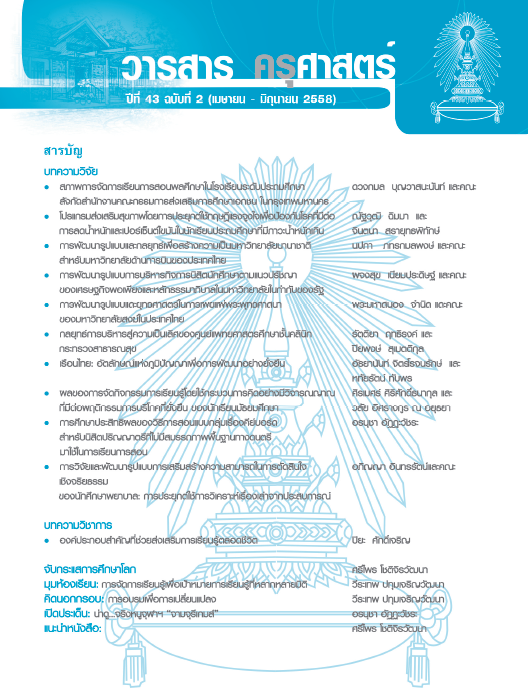โปรแกรมส่งเสริมสุขภาพโดยการประยุกต์ใช้ทฤษฎีแรงจูงใจเพื่อป้องกันโรคที่ ในนักเรียนประถมศึกษาที่มีภาวะน้ำหนักเกิน
Keywords:
HEALTH PROMOTION PROGRAM, PROTECTION MOTIVATION THEORY, WEIGHT LOSS, BODY FAT PERCENTAGE, OVERWEIGHT, โปรแกรมส่งเสริมสุขภาพ, ทฤษฎีแรงจูงใจเพื่อป้องกันโรค, การลดน้ำหนัก, เปอร์เซ็นต์ไขมัน, ภาวะน้ำหนักเกินAbstract
การวิจัยครั้งนี้มีวัตถุประสงค์เพื่อศึกษาผลของโปรแกรมส่งเสริมสุขภาพโดยการประยุกต์ใช้ทฤษฎีแรงจูงใจเพื่อป้องกันโรคที่มีต่อการลดน้ำหนักและเปอร์เซ็นต์ไขมันในนักเรียนประถมศึกษาที่มีภาวะน้ำหนักเกิน กลุ่มตัวอย่างเป็นนักเรียนชั้นประถมศึกษา ที่มีภาวะน้ำหนักเกิน โรงเรียนวิชากร จำนวน 46 คน แบ่งเป็น 2 กลุ่มคือ นักเรียนกลุ่มทดลอง จำนวน 23 คน ได้รับโปรแกรมส่งเสริมสุขภาพตามทฤษฎีแรงจูงใจเพื่อป้องกันโรคที่มีต่อการลดน้ำหนักและเปอร์เซ็นต์ไขมัน เป็นเวลา 8 สัปดาห์ สัปดาห์ละ 3 วัน วันละ 1 ชั่วโมง และนักเรียนกลุ่มควบคุม จำนวน 23 คน ไม่ได้รับโปรแกรมส่งเสริมสุขภาพ เครื่องมือที่ใช้ในการวิจัยและเก็บรวบรวมข้อมูลประกอบด้วย โปรแกรมส่งเสริมสุขภาพโดยการประยุกต์ใช้ทฤษฎีแรงจูงใจเพื่อป้องกันโรคที่มีต่อการลดน้ำหนักและเปอร์เซ็นต์ไขมันมีค่าดัชนีความสอดคล้องเท่ากับ 0.98 และเครื่องชั่งน้ำหนักและวัดเปอร์เซ็นต์ไขมันทานิต้า (Tanita Model: UM-076) วิเคราะห์ข้อมูลโดยการหาค่าเฉลี่ย ค่าส่วนเบี่ยงเบนมาตรฐาน และเปรียบเทียบผลการวิเคราะห์ข้อมูลด้วยสถิติทดสอบทีที่ระดับนัยสำคัญทางสถิติ .05
ผลการวิจัยแสดงให้เห็นว่า โปรแกรมส่งเสริมสุขภาพตามทฤษฎีแรงจูงใจเพื่อป้องกันโรค สามารถลดน้ำหนักตัวและเปอร์เซ็นต์ไขมันของนักเรียนประถมศึกษาที่มีภาวะน้ำหนักเกินได้ดังนี้1) ค่าเฉลี่ยของน้ำหนักตัวและเปอร์เซ็นต์ไขมันของนักเรียนกลุ่มทดลองหลังได้รับโปรแกรมส่งเสริมสุขภาพ ลดลงกว่าก่อนการทดลอง อย่างมีนัยสำคัญทางสถิติที่ระดับ .052) ค่าเฉลี่ยของน้ำหนักตัวและเปอร์เซ็นต์ไขมันของนักเรียนกลุ่มทดลอง หลังได้รับโปรแกรมส่งเสริมสุขภาพ ลดลงกว่านักเรียนกลุ่มควบคุม อย่างมีนัยสำคัญทางสถิติที่ระดับ .05
The purposes of this study were to study a health promotion program based on protection motivation theory for overweight elementary school students to achieve weight loss. The participantswere 46 overweight elementary school students in Wichakorn School who were divided into 2 groups of 23 students. The experimental group received the health promotion program based on protection motivation theory for 1 hour per day, 3 days a week for 8 weeks while the control group did not receive instruction based on the health promotion program. The research instruments were composed of the health promotion program based on protection motivation theory which had an IOC of 0.98. Data was collected using Tanitadigital scales for weight & body fat measurement (Tanita Model: UM-076). The data were then analyzed by means, standard deviations and t-test with statistical significance at .05 levels.
The research findings revealed that the health promotion program based on protection motivation theory was effective in reducing weight loss and body fat percentage of overweight elementary school students. The results were as follows: 1) The mean scores of weight loss and body fat percentage of the experimental group after treatment with the health promotion program were significantly lower than before at .05 levels. 2) The mean scores of weight loss and body fat percentage of the experimental group after application of the health promotion program were also significantly lower than the control group at .05 levels.



